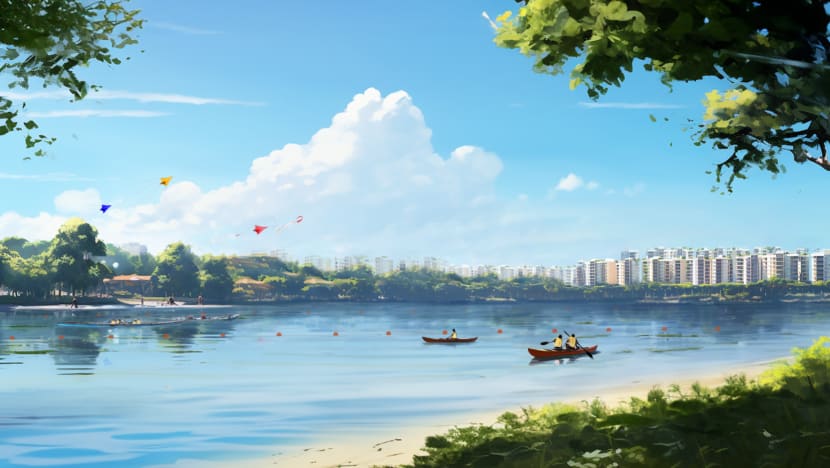'Long Island' reclamation: Imported sand must be sourced from legally permissible areas, says Desmond Lee
The National Development Minister was responding to questions in parliament on the import of reclamation sand to Singapore for the "Long Island" project off East Coast.

An artist's impression of a view from East Coast Park towards Long Island. (Image: URA)

This audio is generated by an AI tool.
SINGAPORE: Importers seeking to bring reclamation sand to Singapore must abide by the laws and regulations of the source countries, including sourcing sand from legally permissible areas, said National Development Minister Desmond Lee on Tuesday (Jan 9).
Such importers must also obtain the proper export documentation and permits from the relevant authorities, as well as comply with local environmental regulations on properly extracting and transporting sand within source countries, Mr Lee added.
He was addressing questions filed by Members of Parliament on various aspects of the “Long Island” reclamation project off East Coast Park.
Mr Lee had announced in November last year that Singapore would begin technical studies this year into the “Long Island” concept, which could involve around 800ha of reclaimed land – the size of more than 1,000 football fields.
Coastal protection measures are at the heart of the plan, which will take a few decades to plan and implement given its scale.
Mr Lee reiterated to the House on Tuesday that the government is at very early stages in the process – kickstarting environmental and engineering studies to determine the feasibility as well as the shape and form of “Long Island”.
These studies will be carried out over the next five years.
SAND IMPORTED FROM "VARIETY OF SOURCES"
Questions on the importation of sand to be used in the project were raised in parliament by Associate Professor Jamus Lim (WP-Sengkang), Mr Louis Ng (PAP-Nee Soon) and Ms He Ting Ru (WP-Sengkang).
Assoc Prof Lim asked where the sand will be sourced from, and whether the government will carry out a study to evaluate the social and ecological impact that any sand-dredging works will have on the surrounding ecosystem and communities.
In response, Mr Lee noted that the import of reclamation sand to Singapore is conducted on a commercial basis, and sand is imported “from a variety of sources”.
Importers must abide by the source countries’ rules and regulations, he said.
“Where applicable, our agencies will check that the necessary environmental-related approvals from source countries are in order before contractors are allowed to commence sand imports,” Mr Lee added.
Mr Ng, who cited “particular concern” about the source of sand to be used for Long Island, then asked for a list of countries that Singapore is hoping to import sand from. He also asked if Singapore will have a responsible sourcing framework to evaluate the social and environmental impact of the imported sand.
Mr Lee again noted that Singapore wants to ensure commercial operators that import material for reclamation works minimise the impact of their operations.
“The list of countries where we import from – some of this is available online in terms of the quantity of sand,” he added.
“But when we’re talking about Long Island, this is far into the future. Works are not going to proceed in the near term, so this will be something that will be developed as the technical studies and implementation plans get greater granularity.”
Indonesia and Malaysia banned sea sand exports to Singapore in 2007 and 2019 respectively. According to a Reuters report, Indonesia announced last year that it would lift the ban.
Singapore stopped importing sand from Cambodia in 2016 when the latter imposed a ban following alleged environmental concerns.
Singapore also imports sand from the Philippines and Myanmar, according to media reports.
Detailed environmental studies will be conducted to assess the environmental impact and develop mitigating measures for the "Long Island" reclamation project, said National Development Minister Desmond Lee. Replying to MPs’ questions in Parliament on Tuesday (Jan 9), he said these studies will take into account the surrounding marine habitats. The Government will also explore ways to incorporate nature-based solutions into the design to minimise the environmental impact. Mr Lee said the Government will engage the nature community, academics and researchers, as well as the public before starting reclamation work. As for the planned developments at East Coast Parkway and “Long Island”, Mr Lee said they offer an integrated solution to meet the multiple needs of future generations, including the building of new homes with a quality living environment, comprising coastal and reservoir parks and amenities, as well as creating new jobs. Mr Lee said by reclaiming “Long Island” away from the current coastline, Singapore can achieve coastal protection, strengthen its water supply and create new tracts of land, while retaining the existing East Coast Park largely as it is. Given its scale, planning and implementing of “Long Island” will take a few decades, he said. “We are only at the very beginning of the process,” he said. After the environmental and engineering studies to determine the feasibility as well as the shape and form of “Long Island”, agencies will do further studies to ensure that the area is well-developed with quality housing, network of new green spaces integrated with East Coast Park and good transport connectivity.
Assoc Prof Lim then asked about the mechanisms to ensure that governmental agency JTC Corporation complies with the government's stipulations on the importation of sand.
He also echoed Mr Ng in seeking a broader framework for the acquisition of sand.
“I think what we want to avoid is a situation where we get just all the valid paperwork, but we violate the spirit of acquiring sand in an ethical fashion,” added Assoc Prof Lim.
Mr Lee told the House that JTC and other agencies procure sand on a commercial basis from operators, and there are requirements in tender specifications that these operators comply with certain rules and regulations – particularly those of the source country.
Ms He sought clarification on how often Singapore agencies conduct checks with their overseas counterparts on imported sand, and what triggers these checks.
She further questioned if Singapore’s current regime is strict enough to ensure that illegal mining and smuggling of sand do not take place when sand is exported to Singapore.
Mr Lee reiterated Singapore’s safeguards, adding that agencies will “look out for and receive information from a variety of sources if there is a sense of non-compliance” with contractual or regulatory rules.
ENVIRONMENTAL, POPULATION IMPACT
Apart from this, Mr Ng and Dr Lim Wee Kiak (PAP-Sembawang) asked about the possible environmental impact of Long Island, while Ms Cheryl Chan (PAP-East Coast) asked about the considerations for population and developmental planning along East Coast Parkway.
Mr Lee said that as with all other land reclamation projects, detailed environmental studies will be conducted to assess the environmental impact of Long Island before the government proceeds with the project.
He added: “These studies will take into account surrounding marine habitats, including intertidal flats and coral communities.
“We will also explore ways to incorporate nature-based solutions into the design of Long Island to minimise the environmental impact of the reclamation, as we mitigate the effects of sea-level rise.”
Before reclamation works begin, the government will engage the nature community, academics and the public for feedback on the environmental studies and mitigation studies.
As for the impact of planned developments at East Coast Parkway, Mr Lee said that the key considerations are the need for coastal protection for the low-lying East Coast area due to future sea-level rise, as well as the need to create more land to meet Singapore’s longer-term developmental needs.
He added that agencies will, at a later stage, undertake further studies to ensure the area is well-developed.



















